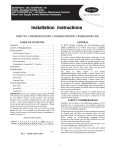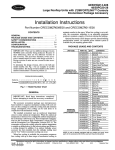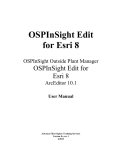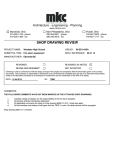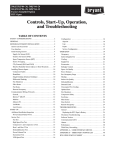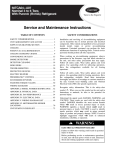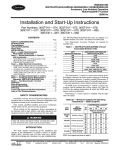Download CAC / BDP BW4RAH-168 Specifications
Transcript
CRSMKKIT002A00 CRSMKSEN002A00 FIELD INSTALLED SMOKE DETECTORS FOR MEDIUM ROOFTOP UNITS 15 to 25 TONS Installation Instructions TABLE OF CONTENTS SAFETY CONSIDERATIONS PACKAGE CONTENTS . . . . . . . . . . . . . . . . . . . . . . . . . . . . . . 1 Installation and servicing of air-- conditioning equipment can be hazardous due to system pressure and electrical components. Only trained and qualified service personnel should install, repair, or service air-- conditioning equipment. Untrained personnel can perform the basic maintenance functions. All other operations should be performed by trained service personnel. When working on air-- conditioning equipment, observe precautions in the literature, tags and labels attached to the unit, and other safety precautions that may apply. Follow all safety codes. Wear safety glasses and work gloves. Recognize safety information. This is the safety-- alert . When you see this symbol on the unit and in symbol instructions or manuals, be alert to the potential for personal injury. Understand the signal words DANGER, WARNING, and CAUTION. These words are used with the safety-- alert symbol. DANGER identifies the most serious hazards which will result in severe personal injury or death. WARNING signifies a hazard which could result in personal injury or death. CAUTION is used to identify unsafe practices which may result in minor personal injury or product and property damage. NOTE is used to highlight suggestions which will result in enhanced installation, reliability, or operation. SAFETY CONSIDERATIONS . . . . . . . . . . . . . . . . . . . . . . . . . 1 GENERAL . . . . . . . . . . . . . . . . . . . . . . . . . . . . . . . . . . . . . . . . . 2 DESCRIPTIONS . . . . . . . . . . . . . . . . . . . . . . . . . . . . . . . . . . . . 2 FEATURES . . . . . . . . . . . . . . . . . . . . . . . . . . . . . . . . . . . . . . . . 2 INDICATORS . . . . . . . . . . . . . . . . . . . . . . . . . . . . . . . . . . . . . . 3 INSTALLATION . . . . . . . . . . . . . . . . . . . . . . . . . . . . . . . . . . . . 3 SENSOR AND CONTROLLER TESTS . . . . . . . . . . . . . . . . . . 9 DETECTOR CLEANING . . . . . . . . . . . . . . . . . . . . . . . . . . . . 10 TROUBLESHOOTING . . . . . . . . . . . . . . . . . . . . . . . . . . . . . . 11 GUIDE SPECIFICATIONS . . . . . . . . . . . . . . . . . . . . . . . . . . . 12 IMPORTANT: Read these instructions completely before attempting to install the smoke detector. PACKAGE CONTENTS CRSMKKIT002A00 ITEM PART NUMBER QTY Harness Assembly 50HEHMRASTA00 1 Pickup Tube RN20ZT060 1 Sensor Cable (10’) RM91ZT015 1 Sensor Cable (5’) RM91ZT005 1 Connector HW92JY003 1 Screw #8 AL56AU168 7 Sampling Tube 48HG503589 1 Coupling 48HG501713 1 Sensor Bracket 48HG501658 1 Screw #10 AL48AM217 2 Flexible Tube 50HE501410 1 Wire Ties HY76TB125 6 Smoke Controller HK28ZT001 1 Installation Instruction IIK--- CRSMK05--- 02 1 PACKAGE CONTENTS CRSMKSEN002A00 ITEM PART NUMBER QTY Sensor Kit HK50ZT001 1 Installation Instruction IIK--- CRSMK05--- 02 1 Copyright 2010 CAC / BDP D 7310 W. Morris St. D Indianapolis, IN 46231 Printed in U.S.A. ! WARNING ELECTRICAL SHOCK HAZARD Failure to follow this warning could cause personal injury or death. Disconnect all power to the unit before performing maintenance or service. Unit may automatically start if power is not disconnected. Tag disconnect switch with lockout tag. Edition Date: 06/10 Manufacturer reserves the right to change, at any time, specifications and designs without notice and without obligations. Catalog No:IIK---CRSMK05---02 Replaces: IIK--- CRSMK05--- 01 GENERAL CRSMK These instructions cover the installation of a return, supply or both smoke detectors in rooftop equipment from 15 to 25 tons. These apply to Gas-- Electric, Electric-- Electric and Heat Pump versions. The chart below outlines the quantities required depending on the desire for which option is needed. CRSMKKIT002A00 CRSMKSEN002A00 Return Smoke 1 1 Supply Smoke 1 1 Return and Supply Smoke 1 2 The primary intent of these detectors is to shut down the unit’s air delivery services upon an alarm trip. They are not designed as a substitute for an open area smoke detector nor a substitute for early warning detection or a replacement for a building’s regular fire detection system. Smoke detectors are not designed to detect toxic gases which can build up to hazardous levels in some fires. These devices will not operate without electrical power. As fires frequently cause power interruptions, it is recommended that the installer further safeguards with your local fire protection specialist and code enforcement agency. For installations using two sensors, the duct smoke detector does not differentiate which sensor signals an alarm or trouble condition. The sensor uses a process called differential sensing to prevent gradual environmental changes from triggering false alarms. A rapid change in environmental conditions, such as smoke from a fire, causes the sensor to signal an alarm state but dust and debris accumulated over time does not. Air is introduced to the duct smoke detector’s sensing chamber through a sampling tube that extends into the HVAC duct and is directed back into the ventilation system through an exhaust tube. The difference in air pressure between the two tubes pulls the sampled air through the sensing chamber. When a sufficient amount of smoke is detected in the sensing chamber, the sensor signals an alarm state and the controller automatically takes the appropriate action to shut down fans and blowers, change over air handling systems, notify the fire alarm control panel, etc. ! EQUIPMENT DAMAGE HAZARD Failure to follow this caution may result in damage to equipment. Excess temperature differentials between the ambient air and the sampled air can produce unwanted condensation inside the sensor, which may cause the sensor to function improperly. Precautions should be taken to limit the temperature range and the amount of condensation to which the sensor is exposed. DESCRIPTIONS Controller The controller includes a controller housing, a printed circuit board, and a clear plastic cover. The controller can be connected to one or two compatible duct smoke sensors. The clear plastic cover is secured to the housing with a single captive screw for easy access to the wiring terminals. (See Fig. 1, 3, and 4.) Sensor The sensor includes a plastic housing, a printed circuit board, a clear plastic cover, an exhaust tube, and a sampling tube. The exhaust tube and sampling tube are attached during installation. The sampling tube varies by size, but the correct one is included with the kit. The clear plastic cover permits visual inspections without having to disassemble the sensor. The cover attaches to the sensor housing using four captive screws and forms an airtight chamber around the sensing electronics. System The smoke detector comprises a controller and one or two sensors. Its primary function is to shut down the rooftop unit in order to prevent smoke from circulating throughout the building. It is not to be used as a life saving device. When these smoke detectors are factory installed on the units listed above, no additional sampling tubes are required to be field installed. (See Fig. 5.) The controller is designed for multiple operating voltages and provides relay contacts for connection to fire alarm systems, HVAC controls, and other auxiliary functions. A remote test/reset station can be connected to the controller to provide these functions. CAUTION FEATURES The smoke sensor incorporates the following features: S Environmental compensation with differential sensing for reliable, stable, and drift-- free sensitivity. S Magnet-- activated test/reset switch on sensors. S PCB mounted photoelectric sensor with on-- board intelligence. S Cover tamper switch for added security. S Alarm, Trouble, Dirty, and Power status LEDs. (See Table 1 and Fig. 3.) S Extended temperature and air velocity ranges. S Capable of adding an additional sensors (for a total of two) using the same controller. S Multiple operating voltages. S No tools required to access field connection terminals. S Recessed momentary switch for test/reset of the detector. S One set of normally open alarm initiation contacts for connection to an initiating device circuit on a fire alarm control panel. S Two Form-- C auxiliary alarm relays for interface with rooftop unit or other equipment. 2 INDICATORS Normal State The smoke detector operates in the normal state in the absence of any trouble conditions and when its sensing chamber is free of smoke. In the normal state, the Power LED on both the sensor and the controller are on and all other LEDs are off. Multiple Detector Operation The interconnect feature of the smoke detector allows up to 15 smoke detectors to be connected to each other, typically for multiple fan shutdown applications. When one of the smoke detectors goes into alarm, it operates as described above. On the remaining smoke detectors not in alarm, only the following occurs: S The auxiliary relay contacts switch positions. S The remote LED output is activated (turned on). INSTALLATION Installing Controller (Supply, Return or Both) 1. Locate smoke controller in kit. (See Fig. 1.) 2. Remove plastic cover from controller. (See Fig. 3.) 3. With harness from kit, plug the harness to controller as shown in wiring label. (See Fig. 4.) 4. For return smoke, locate 5’ sensor cable (RM91ZT005) and plug into phone jack (RJ45) on smoke sensor by routing cable through one of the knock outs in plastic case. For supply smoke, use the 10’ cable (RM91ZT015) instead of the 5’ cable. For both supply and return utilize both cables. 5. Reinstall the plastic cover. 6. Using two #8 screws, mount assembly into predrilled holes located next to central terminal board oriented as shown in diagram. (See Fig. 6.) 7. Complete the wiring of the harness into the unit control terminal board as shown in wiring diagram. (See Fig. 5.) 8. Cut smoke detector jumper on control terminal board as shown in Fig. 6. Alarm State The smoke detector enters the alarm state when the amount of smoke particulate in the sensor’s sensing chamber exceeds the alarm threshold value. (See Table 1.) Upon entering the alarm state: S The sensor’s Alarm LED and the controller’s Alarm LED turn on. S The contacts on the controller’s two auxiliary relays switch positions. S The contacts on the controller’s alarm initiation relay close. S The controller’s remote alarm LED output is activated (turned on). S The controller’s high impedance multiple fan shutdown control line is pulled to ground Trouble state. The SuperDuct duct smoke detector enters the trouble state under the following conditions: S A sensor’s cover is removed and 20 minutes pass before it is properly secured. S A sensor’s environmental compensation limit is reached (100% dirty). S A wiring fault between a sensor and the controller is detected. Trouble Alarm Power Test/reset switch An internal sensor fault is detected upon entering the trouble state: S The contacts on the controller’s supervisory relay switch positions. (See Fig. 1.) S If a sensor trouble, the sensor’s Trouble LED the controller’s Trouble LED turn on. S If 100% dirty, the sensor’s Dirty LED turns on and the controller’s Trouble LED flashes continuously. S If a wiring fault between a sensor and the controller, the controller’s Trouble LED turns on but not the sensor’s. C07298 Fig. 1 -- Controller Assembly Magnetic test/reset switch NOTE: All troubles are latched by the duct smoke detector. The trouble condition must be cleared and then the duct smoke detector must be reset in order to restore it to the normal state. Alarm Trouble Power Dirty C07297 Fig. 2 -- Sensor Assembly 3 CRSMK S One Form-- C supervision (trouble) relay to control the operation of the Trouble LED on a remote test/reset station. S Can be wired to up to 14 other duct smoke detectors for multiple fan shutdown applications. Conduit support plate Terminal block cover Controller housing and electronics Cover gasket (ordering option) CRSMK Controller cover Fastener (2X) C09683 Fig. 3 -- Controller Exploded View C09684 Fig. 4 -- Smoke Detector Wiring 4 CRSMK Controller Return Smoke Sensor C09687 Fig. 5 -- Return Smoke Sensor Installing Return Smoke Sensor 6. Slide tube through the hole in the control box where plug button was previously removed. Pickup tube always goes through the left hole when looking into the control box. Insert until sensor mates against the control box. (See Fig. 8.) 7. Utilizing two #8 screws mount sensor into utilizing predrilled holes. 8. If not previously installed remove end access or economizer access panels to mount pick up tube as described in step 5. 9. Utilizing 5’ cable previously installed plug sensor end into RJ45 female phone connecter by entering sensor through knockout. Ensure that knockout is sealed utilizing grommet which is mounted on cable. 10. Reinstall plastic cover. 11. Utilizing wire ties provided secure cable to control box harness. Avoid sharp edges or inhibiting components in control box. 12. If return only is desired restore power and refer to sensor and controller tests section. 1. Remove the two 1-- 1/4” plug buttons located in the main control box of the unit. 2. Locate Sensor from the CRSMKSEN002A00 kit. (See Fig. 2.) 3. Remove plastic cover from the sensor. (See Fig. 7.) 4. Utilizing adapter from kit snap the pickup tube (RN20ZT060) into the adapter and plug the other end of the tube with red cap. (See Fig. 7.) 5. If room permits the pickup tube can now be installed in the smoke sensor. Orient the holes so that they point into the direction of flow. If unit is a vertical return that would orient the holes toward the vertical opening. If unit is horizontal return that would orient the holes away from evaporator coil. 5 CRSMK Smoke Jumper C09688 Fig. 6 -- Central Terminal Board Exhaust tube Exhaust gasket Sensor housing and electronics See Detail A Intake gasket Cover gasket (ordering option) TSD-CO2 (ordering option) Sensor cover Plug Sampling tube Coupling Detail A C09682 Fig. 7 -- Smoke Sensor Exploded View 6 CRSMK C09686 Fig. 8 -- Return Smoke Sensor Installed (Shown in Vertical) Installing Supply Smoke Sensor 10. Locate box to seal tight connector located in kit. Snap connector into knockout hole. 11. Route seal tight to connecter install and complete connection. Refer to Fig. 9 for routing of seal tight. Ensure that seal tight does not obstruct operation of blower. Cut any excess seal tight. 12. Route 10’ cable through opening on lower right of control box. Route with indoor fan wires securing cable to wires utilizing wire ties provided. 13. Route into sensor through knockout hole and plug end into RJ45 connector. Ensure that knockout hole is sealed with grommet mounted to cable. 14. Reinstall plastic cover. 15. Installation is complete. Refer to sensor and controller section. 1. Remove blower access panel. 2. Locate bracket and secure to fan deck as shown in diagram. Secure with #10 screws provided in kit. (See Fig. 9.) 3. Locate Sensor from the CRSMKSEN002A00 kit. (See Fig. 2.) 4. Remove plastic cover from sensor. (See Fig. 7.) 5. Mount sensor to bracket as shown in figure using 2 #8 screws. 6. Install plastic adapter into the smoke sensor. 7. Locate short pick up tube and EMT to seal tight connector. Secure adapter to pickup tub. 8. Locate seal tight and secure it to the adapter. Snap assembly into the smoke sensor. 9. Remove 7/8” knockout in blower side plate. Refer to Fig. 9 for location depending on configuration of unit. 7 PICK-UP TUBE EMT TO SEAL TIGHT CONNECTOR CRSMK BRACKET KNOCKOUT LOCATION FOR HORIZONTAL HORIZONTAL ASSEMBLY KNOCKOUT LOCATION FOR VERTICAL VERTICAL ASSEMBLY C09685 Fig. 9 -- Supply Smoke 8 SENSOR AND CONTROLLER TESTS ! Sensor Alarm Test OPERATIONAL TEST HAZARD Failure to follow this caution may result in personnel and authority concern. Pressing the controller’s test/reset switch for longer than seven seconds will put the duct detector into the alarm state and activate all automatic alarm responses. The sensor alarm test checks a sensor’s ability to signal an alarm state. This test requires that you use a field provided SD-- MAG test magnet. CAUTION OPERATIONAL TEST HAZARD Failure to follow this caution may result in personnel and authority concern. This test places the duct detector into the alarm state. Unless part of the test, disconnect all auxiliary equipment from the controller before performing the test. If the duct detector is connected to a fire alarm system, notify the proper authorities before performing the test. Sensor Alarm Test Procedure 1. Hold the test magnet where indicated on the side of the sensor housing for seven seconds. 2. Verify that the sensor’s Alarm LED turns on. 3. Reset the sensor by holding the test magnet against the sensor housing for two seconds. 4. Verify that the sensor’s Alarm LED turns off. Dirty Controller Test Procedure 1. Press the controller’s test/reset switch for two seconds. 2. Verify that the controller’s Trouble LED flashes. Dirty Sensor Test The dirty sensor test provides an indication of the sensor’s ability to compensate for gradual environmental changes. A sensor that can no longer compensate for environmental changes is considered 100% dirty and requires cleaning or replacing. You must use a field provided SD-- MAG test magnet to initiate a sensor dirty test. The sensor’s Dirty LED indicates the results of the dirty test as shown in Table 1. ! OPERATIONAL TEST HAZARD Failure to follow this caution may result in personnel and authority concern. Holding the test magnet against the sensor housing for more than seven seconds will put the duct detector into the alarm state and activate all automatic alarm responses. Controller Alarm Test The controller alarm test checks the controller’s ability to initiate and indicate an alarm state. ! CAUTION OPERATIONAL TEST HAZARD Failure to follow this caution may result in personnel and authority concern. This test places the duct detector into the alarm state. Disconnect all auxiliary equipment from the controller before performing the test. If the duct detector is connected to a fire alarm system, notify the proper authorities before performing the test. Controller Alarm Test Procedure CAUTION Table 1 – Dirty LED Test Flashes Description 1 0--- 25% dirty. (Typical of a newly installed detector) 2 25--- 50% dirty 3 51--- 75% dirty 4 76--- 99% dirty Dirty Sensor Test Procedure 1. Hold the test magnet where indicated on the side of the sensor housing for two seconds. 2. Verify that the sensor’s Dirty LED flashes. 1. . Press the controller’s test/reset switch for seven seconds. 2. Verify that the controller’s Alarm LED turns on. 3. Reset the sensor by pressing the test/reset switch for two seconds. 4. Verify that the controller’s Alarm LED turns off. Dirty Controller Test The dirty controller test checks the controller’s ability to initiate a dirty sensor test and indicate its results. 9 CRSMK ! CAUTION Changing the Dirt Sensor Test By default, sensor dirty test results are indicated by: S The sensor’s Dirty LED flashing. S The controller’s Trouble LED flashing. S The controller’s supervision relay contacts toggle. The operation of a sensor’s dirty test can be changed so that the controller’s supervision relay is not used to indicate test results. When two detectors are connected to a controller, sensor dirty test operation on both sensors must be configured to operate in the same manner. CRSMK ! 4. Verify that the test/reset station’s Alarm LED turns off. Remote Test/Reset Station Dirty Sensor Test The test/reset station dirty sensor test checks the test/reset station’s ability to initiate a sensor dirty test and indicate the results. It must be wired to the controller as shown in Fig. 8 and configured to operate the controller’s supervision relay. For more information, see “Changing sensor dirty test operation.” ! CAUTION OPERATIONAL TEST HAZARD Failure to follow this caution may result in personnel and authority concern. If the test/reset station’s key switch is left in the RESET/TEST position for longer than seven seconds, the detector will automatically go into the alarm state and activate all automatic alarm responses. OPERATIONAL TEST HAZARD Failure to follow this caution may result in personnel and authority concern. Changing the dirty sensor test operation will put the detector into the alarm state and activate all automatic alarm responses. Before changing dirty sensor test operation, disconnect all auxiliary equipment from the controller and notify the proper authorities if connected to a fire alarm system. ! Dirty Sensor Test Using an SD--TRK4 1. Turn the key switch to the RESET/TEST position for two seconds. 2. Verify that the test/reset station’s Trouble LED flashes. Remote Station Test The remote station alarm test checks a test/reset station’s ability to initiate and indicate an alarm state. ! CAUTION OPERATIONAL TEST HAZARD Failure to follow this caution may result in personnel and authority concern. This test places the duct detector into the alarm state. Unless part of the test, disconnect all auxiliary equipment from the controller before performing the test. If the duct detector is connected to a fire alarm system, notify the proper authorities before performing the test. CAUTION OPERATIONAL TEST HAZARD Failure to follow this caution may result in personnel and authority concern. Holding the test magnet to the target area for longer than seven seconds will put the detector into the alarm state and activate all automatic alarm responses. To Configure the Dirty Sensor Test Operation 1. Hold the test magnet where indicated on the side of the sensor housing until the sensor’s Alarm LED turns on and its Dirty LED flashes twice (approximately 60 seconds). 2. Reset the sensor by removing the test magnet then holding it against the sensor housing again until the sensor’s Alarm LED turns off (approximately 2 seconds). CAUTION DETECTOR CLEANING Cleaning the Smoke Detector Clean the duct smoke sensor when the Dirty LED is flashing continuously or sooner if conditions warrant. ! CAUTION OPERATIONAL TEST HAZARD Failure to follow this caution may result in personnel and authority concern. If the smoke detector is connected to a fire alarm system, first notify the proper authorities that the detector is undergoing maintenance then disable the relevant circuit to avoid generating a false alarm. SD--TRK4 Remote Alarm Test Procedure 1. Turn the key switch to the RESET/TEST position for seven seconds. 2. Verify that the test/reset station’s Alarm LED turns on. 3. Reset the sensor by turning the key switch to the RESET/TEST position for two seconds. 10 Sampling tube Controller’s Trouble LED is Flashing 1. One or both of the sensors is 100% dirty. 2. Determine which Dirty LED is flashing then clean that sensor assembly as described in the detector cleaning section. Sensor’s Trouble LED is On 1. Check the sensor’s Dirty LED. If it is flashing, the sensor is dirty and must be cleaned. 2. Check the sensor’s cover. If it is loose or missing, secure the cover to the sensor housing. 3. Replace sensor assembly. Sensor’s Power LED is Off 1. Check the controller’s Power LED. If it is off, determine why the controller does not have power and make the necessary repairs. 2. Check the wiring between the sensor and the controller. If wiring is loose or missing, repair or replace as required. HVAC duct Sensor housing Controller’s Power LED is Off 1. Make sure the circuit supplying power to the controller is operational. If not, make sure JP2 and JP3 are set correctly on the controller before applying power. 2. Verify that power is applied to the controller’s supply input terminals. If power is not present, replace or repair wiring as required. Optic plate Airflow Retainer clip Optic housing C07305 Fig. 10 -- Sensor Cleaning Diagram Remote Test/Reset Station’s Trouble LED Does Not flash When Performing a Dirty Test, But the Controller’s Trouble LED Does 1. Verify that the remote test/station is wired as shown in Fig. 8. Repair or replace loose or missing wiring. 2. Configure the sensor dirty test to activate the controller’s supervision relay. See “Changing sensor dirty test operation.” TROUBLESHOOTING Controller’s Trouble LED is On 1. Check the Trouble LED on each sensor connected to the controller. If a sensor’s Trouble LED is on, determine the cause and make the necessary repairs. 2. Check the wiring between the sensor and the controller. If wiring is loose or missing, repair or replace as required. Sensor’s Trouble LED is On, But the Controller’s Trouble LED is OFF Remove JP1 on the controller. 11 CRSMK 1. Disconnect power from the duct detector then remove the sensor’s cover. (See Fig. 10.) 2. Using a vacuum cleaner, clean compressed air, or a soft bristle brush, remove loose dirt and debris from inside the sensor housing and cover. Use isopropyl alcohol and a lint-- free cloth to remove dirt and other contaminants from the gasket on the sensor’s cover. 3. Squeeze the retainer clips on both sides of the optic housing then lift the housing away from the printed circuit board. 4. Gently remove dirt and debris from around the optic plate and inside the optic housing. 5. Replace the optic housing and sensor cover. 6. Connect power to the duct detector then perform a sensor alarm test. GUIDE SPECIFICATIONS Controller Specifications A. Dimensions S Controller only: 6.75 x 5.45 x 1.90 in. S Controller and detector: 14.51 x 5.45 x 1.90 in. B. Operating Environment S Temperature: - 20_ to 158_F (-- 29_ to 70_C) S Humidity: 10% to 93% RH, non-- condensing G. Reset Time S 2 second maximum H. Power Up Time S 8 second maximum I. Alarm Test Response Time S 5 to 7 second J. LED Indicators S S S S C. Wire Size S High voltage terminals: 12-- 22 AGW S All others: 14-- 22 AGW CRSMK D. Operating Voltages S 20-- 29 VAC, 50/60 Hz S 120 VAC, 50/60 Hz S 220/240 VAC, 50/60 Hz E. Operating Current S 20-- 29VDC: 175 mA S 24 VAC: 500 mA at 50/60 Hz S 120 VAC: 100 mA at 50 Hz 75 mA at 60 Hz S 220/240 VAC: 53 mA at 50 Hz 40 mA at 60 Hz Remote Keyed Attenuator and Test/Reset Station Specifications (KA--99ZT--003) A. Compatibility with electrical boxes S North American 1-- gang box S Standard 4-- in. square box, 1-- 1/2 in. deep, with 1-- gang cover B. LED Indicators S Red (Alarm) S Yellow (Trouble) S Green (Power) F. LED Indicators S Red (Alarm) S Yellow (Trouble) S Green (Power) C. LED Type S Clear lens D. Wire Size S 14 to 22 AWG G. Relays S Alarm initiation relay Quantity: 1 Style: Normally open Ratings: 2.0A at 30 VDC (resistive) S Auxiliary relay Quantity: 1 Style: Form C Ratings: 10A at 30 VDC, 10A at 250 VAC S Supervision (trouble) relay Quantity: 1 Style: Form C Ratings: 2.0A at 30 VDC (resistive) Detector Specifications Red (Alarm) Yellow (Trouble) Yellow (Dirty) Green (Power) E. Resistance per Wire S 10 Ω, max F. Operating Current Same as controller specification G. Operating Voltages S 24 Vdc, 24V at 50/60 Hz S 120V at 50/60 Hz S 220/240V at 50/60 Hz H. Compatible Detectors S SuperDuct Four-- Wire smoke detectors I. Operating Environment S Temperature: 32_ to 131_F (0_ to 55_C) S Humidity: 93% RH, non-- condensing J. Storage Temperature S - 20_ to 60_C (-- 4_ to 140_F) A. Sensor S 8.70 x 5.45 x 1.90 in. B. Smoke Detection Method S Photoelectric C. Operating Environment S Same as controller D. Air Velocity (Min--Max) S 100-- 4,000 ft/min E. Pressure Differential (Min--Max) S 0.005-- 1.00 in. F. Sensitivity S 0.67 to 2.48 %obscuration/ft S Wire size: 14 to 22 AGW 12












